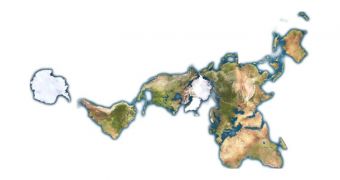Investigators with the Steinmann Institute of Geosciences at the University of Bonn say that new computer models are beginning to reveal a clearer picture of how Earth's first continents formed. New measurements refined previously-unclear aspects of how land and water differentiated.
Earth's continental crust is only about 30 to 40 kilometers (18.6 to 24.8 miles) thick, much more so than the thinner, oceanic crust, which is about half that size. Additionally, the former is also a lot lighter, since it's of lower density.
The current theory on how the first continents emerged is based on sample analyses of 3.8-billion-year-old rocks collected from western Greenland. It stats that the first continent appeared when two tectonic plates collided with each other, and one was forced into the mantle.
The plate that was submerged would melt partially once it reached a depth of about 100 kilometers (60 miles). All that molten rock would then ascend back to the surface, and literally push up the first continents ever to grace the face of our beautiful planet.
New computer simulations conducted at the SIG refined some of the aspects in this established theory.
“Our results paint a surprising picture. The oceanic crust did not have to descend to a depth of 100 kilometers to create the molten rock that makes up the rocks of the first continents,” says Dr. Thorsten Nagel, the lead author of the new study.
The expert, who holds an appointment as an adjunct professor at SIG, says that a depth of 30 to 40 kilometers (18.6 to 24.8 miles) is much more probable for the melting of tectonic plates submerged in the mantle.
“Trace elements provide geologists with a window to the origin of continental crust. With their help, we can identify minerals in the residual rock that were deposited in the depths by the molten rock,” adds Dr. Carsten Münker, quoted by Astrobiology Magazine.
The expert holds an appointment with the Institute of Geology and Mineralogy at the University of Cologne. “We think it is unlikely that the contents were formed into subduction zones. Whether or not tectonic plates of the primordial Earth had such zones of subsidence is still a matter of debate,” the research team says.

 14 DAY TRIAL //
14 DAY TRIAL //